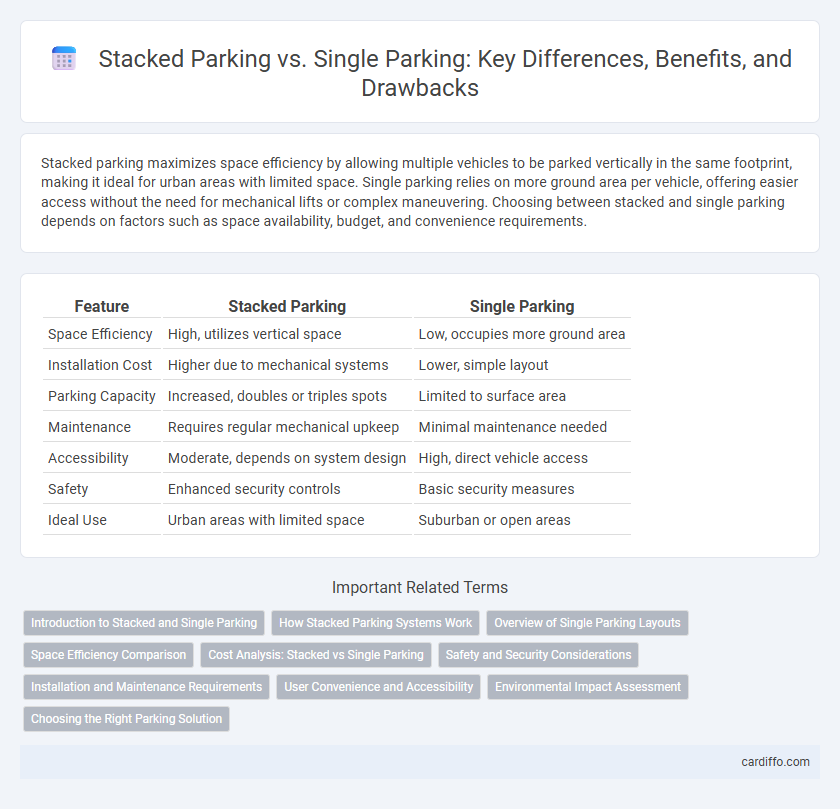Stacked parking maximizes space efficiency by allowing multiple vehicles to be parked vertically in the same footprint, making it ideal for urban areas with limited space. Single parking relies on more ground area per vehicle, offering easier access without the need for mechanical lifts or complex maneuvering. Choosing between stacked and single parking depends on factors such as space availability, budget, and convenience requirements.
Table of Comparison
| Feature | Stacked Parking | Single Parking |
|---|---|---|
| Space Efficiency | High, utilizes vertical space | Low, occupies more ground area |
| Installation Cost | Higher due to mechanical systems | Lower, simple layout |
| Parking Capacity | Increased, doubles or triples spots | Limited to surface area |
| Maintenance | Requires regular mechanical upkeep | Minimal maintenance needed |
| Accessibility | Moderate, depends on system design | High, direct vehicle access |
| Safety | Enhanced security controls | Basic security measures |
| Ideal Use | Urban areas with limited space | Suburban or open areas |
Introduction to Stacked and Single Parking
Stacked parking maximizes space utilization by allowing multiple vehicles to be parked vertically using mechanical lifts or platforms, ideal for urban areas with limited ground space. Single parking involves standard ground-level spaces where each vehicle occupies a separate spot, offering ease of access and simplicity. Choosing between stacked and single parking depends on factors such as available space, budget, and user convenience requirements.
How Stacked Parking Systems Work
Stacked parking systems utilize vertical space by placing vehicles on platforms that can be mechanically or hydraulically lifted and moved to create multiple levels of parking within the footprint of a single car space. These systems use lifts, shuttles, or conveyors to transport cars to designated parking spots, optimizing space efficiency and reducing land use. By automating vehicle movement, stacked parking enhances urban parking capacity without expanding the parking lot area.
Overview of Single Parking Layouts
Single parking layouts maximize individual vehicle access by allocating one dedicated space per car, promoting ease of entry and exit without obstruction. These layouts commonly include parallel, perpendicular, and angled configurations, each optimized for different spatial constraints and traffic flow. Effective design of single parking areas improves safety, reduces vehicle damage, and enhances overall parking efficiency in diverse environments.
Space Efficiency Comparison
Stacked parking maximizes spatial efficiency by allowing multiple vehicles to occupy the same vertical footprint, effectively doubling or tripling capacity in limited areas. Single parking consumes significantly more horizontal space, making it less suitable for dense urban environments or compact lots. Vertical integration in stacked systems optimizes land use, reduces the overall parking lot size, and enhances accessibility in constrained developments.
Cost Analysis: Stacked vs Single Parking
Stacked parking systems typically reduce land use and construction costs by accommodating more vehicles in the same footprint compared to single parking layouts, which require expansive surface area. Initial investment in stacked parking may be higher due to mechanical components, yet long-term savings arise from optimized space utilization and reduced land acquisition expenses. Operational costs for maintenance and potential mechanical repairs in stacked parking must be weighed against the higher land and paving costs inherent in single parking configurations.
Safety and Security Considerations
Stacked parking systems maximize space efficiency but require secure locking mechanisms and regular maintenance to prevent mechanical failures that could compromise safety. Single parking spaces offer easier access and exit, reducing the risk of vehicle damage or personal injury during parking maneuvers. Surveillance cameras and well-lit areas enhance security for both stacked and single parking, deterring theft and vandalism effectively.
Installation and Maintenance Requirements
Stacked parking systems require specialized installation involving mechanical lifts, increasing initial setup complexity and costs compared to single parking, which typically involves straightforward surface or garage spots with minimal equipment. Maintenance for stacked parking demands regular inspections and servicing of mechanical components to ensure safety and functionality, whereas single parking spaces generally need routine cleaning and minimal upkeep. The choice between the two significantly impacts long-term operational efforts due to the technical involvement required in stacked parking system maintenance.
User Convenience and Accessibility
Stacked parking maximizes space efficiency by allowing multiple vehicles to be parked vertically, but it requires users to wait for other cars to be moved, which can reduce convenience and accessibility. Single parking provides direct access to each vehicle, ensuring quicker retrieval and ease of use, especially for those with mobility challenges. Prioritizing user convenience, single parking is often preferred in settings where immediate access is critical.
Environmental Impact Assessment
Stacked parking systems significantly reduce the land footprint required for vehicle storage compared to single parking layouts, leading to decreased soil disruption and lower habitat destruction. By minimizing paved surfaces, stacked parking reduces stormwater runoff and urban heat island effects, contributing to improved local ecosystem health. Reduced land use and optimized space allocation in stacked parking also support better preservation of green spaces and enhance overall sustainability in urban planning.
Choosing the Right Parking Solution
Stacked parking systems maximize space efficiency by allowing multiple vehicles to occupy the same footprint, making them ideal for urban areas with limited real estate. Single parking offers straightforward access and lower installation costs, suitable for locations with ample space and budget constraints. Evaluating factors like available area, budget, and frequency of use is essential to determine whether stacked or single parking better aligns with operational needs.
Stacked Parking vs Single Parking Infographic

 cardiffo.com
cardiffo.com